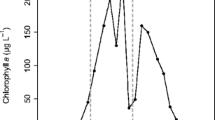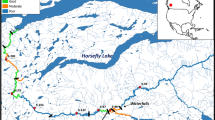Abstract
Sedimentation of organic particles plays a decisive role in streams in relation to pelagic loss as well as retention of nutrients and other substances. The plate sediment trap allows for the direct measurement of these net fluxes. Biweekly measurements were undertaken in the eutrophic lowland River Spree (MQ ∼ 14 m3 s−1) 10 km upstream of Berlin in 1999 and 2000. Trapping rates between 0.5 and 25 g DW m−2 day−1 were found near the bank. The variance of seston sedimentation is controlled by the seston concentration, the settling velocity of the particles and the flow velocity. The sinking velocity exhibits significant seasonal fluctuations with highest values in summer. It is shown that the critical flow velocity for sedimentation is another important parameter. This controls the distribution of sedimentation over the width of the river and thus the effective average sedimentation rate for the entire river segment. This average rate ranged between 0.9 and 6.6 g DW m−2 day−1.
Similar content being viewed by others
References
Bloesch, J., 1982. Inshore-offshore sedimentation differences resulting from resuspension in Eastern Basin of Lake Erie. Can. J. Fish. aquat. Sci. 39: 748-759.
Kaden, S., M. Kirsten & D. Ludewig, 1965. Technische Hydraulik. In Busch, K. F. (ed.), Ingenieurtaschenbuch Bauwesen, Band II. B.G. Teubner Verlagsgesellschaft, Leipzig: 345-464
Köhler, J., 1991. Wachstum, Produktion und Verluste des Phytoplanktons in einem Flachlandfluss (Untere Spree). Diss. Techn. Univers. Dresden: 138 pp.
Kozerski, H. P. & K. Leuschner, 1999. Plate sediment traps for slowly moving waters. Wat. Res. 33: 2913-2922.
Kozerski, H. P., 2002. Determination of areal sedimentation rates in rivers by using plate sediment trap measurements and flow velocity-settling flux relationship. Wat. Res. 36:2983-2990
Kozerski, H. P. & K. Leuschner, 2000. A new plate sediment trap: Design and first experiences. Verh. int. Ver. Limnol. 27: 242-245.
Metha, A. & E. Partheniades, 1975. An investigation of the depositional properties of flocculated fine sediments. J. hydraul. Res. 13: 361-382.
Schellenberger, G., 1981. Hydrologie und Ökologie des Müggelsees. Geogr. Ber. 99: 115-122.
Smith, I. R., 1975. Turbulence in lakes and rivers. Sci. Publ. Freshwater Biological Association, Ambleside, UK. 29: 79 pp.
Svendsen. L. M. & B. Kronvang, 1993. Retention of nitrogen and phosphorus in a Danish lowland river system: Implications for the export from the watershed. Hydrobiologia. 251: 123-135.
Welton, J. S., 1980. Dynamics of sediment and organic detritus in a small chalk stream. Arch. Hydrobiol. 90: 162-181
Author information
Authors and Affiliations
Rights and permissions
About this article
Cite this article
Kozerski, HP. Seston sedimentation in a lowland river (River Spree, Germany): their spatial and temporal variations and controlling factors. Hydrobiologia 494, 51–55 (2003). https://doi.org/10.1023/A:1025477223638
Issue Date:
DOI: https://doi.org/10.1023/A:1025477223638




